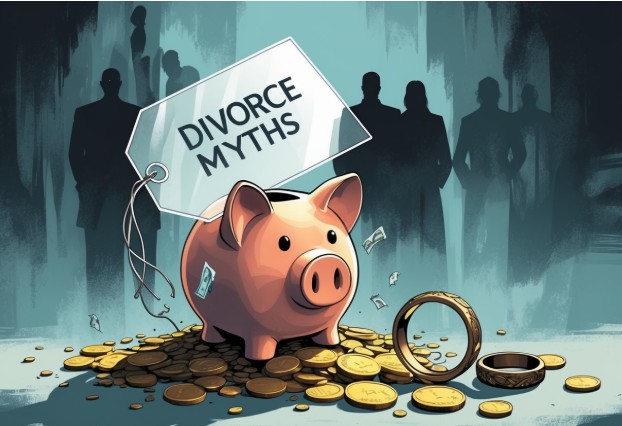

Originally published: August 2025
Many people going through divorce believe common myths that can lead to unexpected costs and financial trouble.
These outdated beliefs, such as the notion that legal fees are the only significant expense or the assumption that assets are split equally, can result in unexpected bills long after the papers are signed.
Understanding the true financial impact of divorce myths helps protect your wallet and your family’s future.
Family law is replete with complex rules, and even minor mistakes in following outdated advice can deplete savings without warning.
People often overlook hidden expenses, such as individual health insurance, new housing costs, and the ongoing costs of shared children’s activities.
When trusted myths guide significant decisions, the real cost can be far greater than expected.
Knowing which beliefs do not align with reality empowers families to make more informed choices during divorce.
By learning what to expect, they can truly prepare for costs that most people never see coming and avoid financial strain for years to come.
Old ideas about divorce can be expensive. Many people spend more money than needed by following outdated beliefs about what divorce should look like, how much it should cost, and how they should protect themselves.
Believing that divorce must always be an ugly, drawn-out court battle can easily drive up costs.
Couples often think that hiring separate lawyers and fighting over every detail is the only way, but this can result in thousands of dollars in legal fees.
Some myths claim that “winning” the divorce is possible or necessary.
Chasing this idea leads people to spend money on aggressive legal strategies, even when a fair, simple solution might be available.
Mediation or collaborative divorce can save money but is often ignored when myths take hold.
Unrealistic ideas about lifestyle after divorce can also cause problems.
Some people expect to keep the same home or standard of living, but the reality is often different.
These beliefs can cause new loans, credit card debt, and long-term financial stress.
Below is a brief table of belief-driven costs:
| Outdated Belief | Potential Cost Impact |
| An aggressive legal battle is necessary | High legal fees |
| One side must “win.” | Extra court hearings |
| The standard of living won’t change | Ongoing debt |
People are most at risk for costly mistakes when emotions are high, right at the start of the divorce process.
Fast decisions are often based on shock, anger, or fear, not careful planning.
During this period, many trust old advice from friends or family more than current information.
The urge to react quickly can lead to hiring expensive lawyers or moving out too soon without a clear plan for finances.
Rushed choices can have lasting effects.
Overlooking hidden costs—such as insurance changes or taxes—can come as a surprise to anyone.
Those who assume “divorce is always expensive” may not look for cheaper options like mediation or online legal help.
Taking the time to ask questions and verify facts can help protect against these risks.
Seeking advice from a financial planner or a legal expert who specializes in divorce can often help individuals avoid common pitfalls.

Many common misconceptions about divorce can have a negative financial impact on individuals.
False ideas about money, property, and support often lead to costly mistakes that persist long after the process is complete.
Both parties can end up responsible for spousal support. The law considers each person’s needs, income, and the length of the marriage.
This means that even someone earning less can be required to pay alimony if they have additional resources or assets.
Many assume child support is only based on salary. Courts consider health insurance, child care, special needs, and occasionally lifestyle factors when determining child support.
Unexpected costs and changes in income can change the amount paid over time.
Divorce law generally splits assets gained during the marriage, regardless of whose name is on the title.
This can surprise those who believe that solely owning a car or a bank account will allow them to keep it.
A judge can throw out parts—or even all—of a prenuptial agreement.
If it’s found unfair or created improperly, one party could lose property they thought was off-limits in a divorce.
Divorce can incur bills and fees that exceed what most people expect, especially when conflict or court involvement is involved.
Delays, additional filings, and extended court appearances can result in significant expenses for both parties.
Divorce is never easy, but Cooper Trachtenberg Law can help you protect what matters and move forward with clarity. Contact us today to discuss your divorce representation needs.
If you’re ready to get started, call us now!

Divorce myths don’t just distort your emotions—they derail your financial future. The good news?
Every myth you unlearn is an opportunity to redirect your money toward lasting stability and growth.
These aren’t just theoretical tips—they’re proven practices that help individuals rebuild their lives with confidence after divorce.
Traditional budgeting advice often overlooks the emotional challenges of divorce. That’s why a restructured version of the 50/30/20 rule works better during recovery, especially when you filter for myth-driven spending.
To prevent impulse buys triggered by stress or sadness, enforce a personal rule: wait 48 hours before making any non-essential purchase greater than $100.
This built-in pause helps override emotional decision-making and brings clarity to what’s truly necessary.
Post-divorce, unclear boundaries with your former spouse often lead to financial entanglement, sometimes under the guise of cooperation or friendship.
If left unchecked, these blurred lines can lead to ongoing expenses that seem unavoidable but are entirely preventable.
Ensure that your bank accounts, financial apps, and expense trackers are fully independent.
If you co-parent, use a shared tool (such as an online resource or a joint spreadsheet) strictly for tracking mutually agreed-upon child-related costs.
Your divorce decree may not cover every financial scenario—field trips, extracurriculars, birthday parties, medical co-pays.
Create a system for pre-approving these discretionary costs. Clear documentation now prevents resentment and financial surprises later.
Splitting vacation costs, paying for each other’s meals, or continuing joint subscriptions are subtle but dangerous habits. These reinforce emotional dependency while compromising your financial autonomy. Establish a clean break—financially and emotionally.
Set aside $1,000 to $2,500 as a buffer for post-divorce emergencies: sudden legal motions, child-related issues, or therapy costs.
This ensures you’re not forced into high-interest borrowing or emotionally driven overspending under pressure.
Myth-driven spending often centers on the past—trying to feel better, get even, or reclaim something lost. Financial recovery demands a forward-focused strategy that builds stability, not image.
Instead of spending thousands on wellness retreats or revenge wardrobes, redirect those funds into certifications, online courses, or skill-building that enhances your earning potential.
For those reentering the workforce or pivoting careers, resume coaching or job prep resources can offer a substantial return on investment.
While high-quality therapy is an expense, it offers long-term value by preventing costly mistakes.
A structured therapeutic plan, especially one that focuses on trauma, identity, and emotional regulation, can help you avoid unnecessary legal costs, career setbacks, or toxic financial decisions rooted in unhealed wounds.
Once financial breathing room appears, resist the urge to inflate your lifestyle. Instead of purchasing a new car or designer upgrades, consider launching a freelance service, investing in a side hustle to make additional money, or saving aggressively toward future milestones.
One of the most expensive mistakes people make after divorce is trying to purchase healing. Whether it’s a yoga retreat, luxury vacation, or “reinvention” program, these experiences often promise clarity but deliver short-term comfort with long-term financial consequences.
A weekend retreat can cost between $3,000 and $10,000. In contrast, a consistent therapy plan—even at $150 per session—offers measurable progress, structured healing, and professional accountability for a fraction of the cost.
Many people underestimate the power of group support. Divorce recovery meetups, church-based programs, or even online communities offer encouragement, accountability, and shared wisdom—often for free or a nominal fee.
Instead of dropping money on the latest self-help fad, explore the wealth of free resources available:
The best investment post-divorce isn’t in things, it’s in skills. Emotional regulation, co-parenting communication, digital literacy, and financial planning all contribute to both emotional peace and economic resilience.
Get a personalized legal roadmap tailored to your goals, whether you’re considering divorce, seeking custody, or modifying support. Contact now.
If you’re ready to get started, call us now!
Breaking free from popular divorce myths can lead to better financial decisions and more money saved during and after divorce.
Making informed decisions based on facts rather than false beliefs helps people retain more of their resources and recover more quickly.
Many people find themselves struggling after divorce because they believe myths like “the lawyer will handle everything” or “splitting assets is always equal.”
Some couples who challenged these myths found better outcomes.
For example, Sarah (a fictionalized name) did not assume she would automatically receive half of everything and, instead, learned how their retirement accounts were valued.
She worked with a financial advisor, avoided common mistakes, and ultimately retained more of her long-term investments.
Mark and Lisa (fictionalized names), after hearing “the court is the only option,” instead tried mediation.
They saved thousands on legal fees and agreed on a fair split faster.
Their children had less stress, and both parents felt more in control.
A table highlighting outcomes:
| Myth Believed | Myth Busted | Positive Results |
| “Lawyer does it all.” | Sought financial planning | Retained more assets |
| “Court is required.” | Tried mediation | Spent less, less stress |
| “Assets always split 50/50.” | Researched state laws | Fairer, smarter outcome |
Actions based on facts, not myths, add up. Choosing mediation can save tens of thousands upfront.
Proper financial planning helps keep savings safe and may even help build wealth after divorce.
When people budget carefully and make decisions with a clear head, their gains grow over time.
Avoiding unnecessary court battles, protecting your credit score, and planning for taxes and retirement all contribute to a stronger financial future.
A small decision today, like asking the right questions or double-checking asset values, can mean having more money in five or ten years. In divorce, knowledge isn’t just power—it’s real savings.
Financial recovery after divorce isn’t just about spreadsheets—it’s about mindset. To truly rebuild, you need a system that not only manages your money but also rewires the emotional habits that caused financial leaks in the first place.
This 30-day detox is designed to reset your relationship with money, expose hidden spending triggers, and help you regain control over your finances.
Followed by a 90-day roadmap, it provides the structure to prevent financial backsliding and start building long-term wealth.
The first step is clarity. Begin tracking every dollar you spend—not just the obvious categories but also the emotional context behind each expenditure.
Was that purchase made out of stress? Guilt? An urge to “keep up”? Label spending accordingly.
This week is not about making changes—it’s about building awareness and establishing a financial baseline for improvement.
Once you’ve identified where the emotional leaks occur, it’s time to establish boundaries—both with yourself and your ex.
Now that you’ve stopped the bleeding, redirect those reclaimed dollars toward areas that support your long-term well-being.
This is the pivot point where money starts working for you again.
The final week is about sustainability. Short-term change is easy; long-term behavior shift is what builds wealth.
A 30-day detox helps clear the fog. But sustainable wealth requires momentum. Here’s what to focus on in the 90 days that follow:
Even after progress, it’s easy to fall back into old habits. Be alert for these red flags:
Outdated beliefs about divorce costs can lead people to make decisions that hurt their finances in the long run.
Many still believe myths about who should pay, what is “fair,” and how money and property are divided.
These ideas can lead to costly surprises. For example, hidden expenses often appear with health insurance, taxes, and housing.
People may also overlook the cost of setting up a new home or the long-term expenses associated with splitting retirement accounts.
This isn’t about restriction. It’s about reclamation. When you stop letting outdated beliefs dictate your spending, you create space for clarity, confidence, and a financial future that reflects your values, not your past.
Your divorce has already cost enough. Don’t let outdated myths cost you your financial future, too.
Your financial future matters. Cooper Trachtenberg Law can help you pursue fair alimony and support arrangements that reflect your needs and goals. Contact us now to start the conversation.
What are the biggest financial mistakes people make after divorce?
The most common financial mistakes after divorce include emotional overspending, failing to create a post-divorce budget, ignoring retirement savings, and keeping financial ties with an ex-spouse.
These decisions often stem from outdated beliefs about what post-divorce life “should” look like, which can lead to long-term financial instability.
How can divorce myths lead to overspending?
Divorce myths encourage emotional decision-making, such as overcompensating with expensive gifts or forcing a friendship with your ex. These behaviors often result in hidden costs—sometimes thousands of dollars per year—to maintain appearances or avoid guilt.
What is a “myth tax” in divorce recovery?
The “myth tax” refers to the extra money people spend because of emotionally driven, outdated beliefs about how they should act after divorce. Examples include costly vacations to “prove” you’re fine or extended legal fees in pursuit of closure. This tax can cost $10,000 to $50,000 or more per year if left unchecked.
How do I create a financial plan after divorce?
Start by tracking expenses, separating your finances from those of your ex, and creating a myth-proof budget using the 50/30/20 rule. Allocate 50% to needs (housing, legal costs), 30% to mindful wants, and 20% to savings or debt repayment. Use a 48-hour rule for all non-essential purchases to avoid emotional spending.
When should I start budgeting after the divorce?
You should start budgeting as soon as the divorce process begins, even before the final decree is issued. Early budgeting helps you assess your new financial reality, prepare for legal and child-related costs, and avoid accumulating post-divorce debt from reactive or guilt-based spending.
How can I rebuild financially after a costly divorce?
Rebuilding starts with eliminating myth-based spending, setting clear financial goals, investing in personal development, and building new income streams. Small, strategic changes—such as reducing unnecessary shared expenses and redirecting funds into savings or skill development—can accelerate financial recovery within 6 to 12 months.